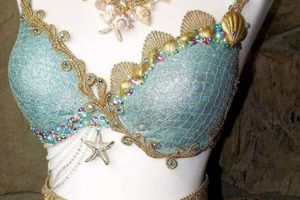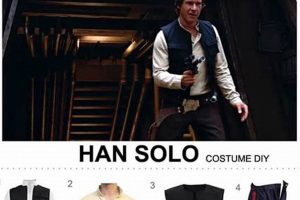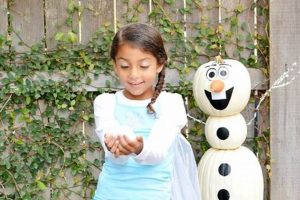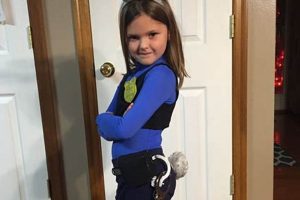A self-assembled zookeeper outfit represents a resourceful approach to costuming, often involving readily available materials and personalized design elements. This type of attire typically simulates the appearance of an individual employed in a zoological setting, overseeing animal care and visitor interaction. For example, common components might include khaki-colored clothing, a fabricated name tag, and toy animal accessories.
The advantage of constructing such apparel lies in its affordability and potential for customization. Compared to purchasing a pre-made costume, a self-assembled version allows for creative expression and the utilization of existing wardrobe items. Historically, homemade costumes have provided an accessible avenue for participation in celebratory events, fostering ingenuity and resourcefulness.
The subsequent sections will delve into specific techniques for creating essential components of this simulated professional uniform, offering guidance on material selection, construction methods, and accessory integration to achieve a convincing and visually appealing result.
Constructing an Authentic Zookeeper Ensemble
Creating a convincing representation of a zookeeper’s attire requires attention to detail and a focus on practicality. The following guidelines offer insights into achieving a professional and believable look using readily accessible materials and simple construction techniques.
Tip 1: Opt for Khaki or Neutral Tones: Select clothing in khaki, olive green, or neutral brown shades. These colors are commonly associated with zookeeping uniforms and project a sense of professionalism.
Tip 2: Incorporate Functional Pockets: Add or utilize existing pockets on the chosen shirt and pants. Pockets are essential for carrying tools, treats, or informational materials, contributing to the authentic appearance.
Tip 3: Design a Realistic Name Tag: Create a name tag featuring a plausible name and job title, such as “Animal Care Specialist” or “Conservation Educator.” Laminating the tag will enhance its durability and professional aesthetic.
Tip 4: Accessorize with Essential Gear: Consider incorporating accessories such as a utility belt, toy binoculars, or a water bottle. These items suggest the practical demands of the zookeeping profession.
Tip 5: Add an Animal-Related Emblem: Affix a patch or pin featuring an animal or zoo logo to the shirt or jacket. This subtle detail reinforces the association with a zoological institution.
Tip 6: Prioritize Comfortable Footwear: Choose sturdy and comfortable shoes or boots that are suitable for prolonged periods of standing and walking. This detail emphasizes the active nature of the zookeeper’s role.
Tip 7: Consider a Faux Radio or Walkie-Talkie: A toy radio or walkie-talkie can add a touch of authenticity, suggesting communication and coordination within the zoo environment.
Following these suggestions will enhance the realism and impact of the simulated zookeeper attire. The result will be a costume that reflects the dedication and professionalism associated with individuals who work in animal care and conservation.
The next section will address the selection of materials and specific construction techniques for assembling the various components of the simulated uniform.
1. Khaki clothing selection
The selection of khaki-colored clothing is a foundational element in constructing a credible self-assembled zookeeper costume. This choice is not arbitrary; the color khaki has become strongly associated with professions involving outdoor work, environmental conservation, and animal care, including the role of a zookeeper. The cause-and-effect relationship is direct: the selection of khaki clothing significantly contributes to the immediate recognizability and authenticity of the zookeeper persona. Without this color association, the costume might be perceived as a generic representation of an outdoor worker rather than a specific portrayal of a zookeeper.
The importance of khaki clothing selection extends beyond mere visual recognition. The color itself is often associated with practicality and durability, mirroring the demands of the zookeeping profession, which involves physical labor and exposure to various environmental conditions. Real-life examples abound: a child wearing a bright pink outfit with toy animals may be seen as simply dressed up, while the same child in khaki clothing with similar accessories is more likely to be immediately identified as a zookeeper. This illustrates the profound impact of color association on the perception of the costume. Furthermore, the use of durable khaki fabric, such as twill or canvas, reinforces the impression of a functional uniform capable of withstanding the rigors of daily tasks.
In summary, the strategic selection of khaki clothing is indispensable for achieving a convincing and readily identifiable self-assembled zookeeper costume. The color choice transcends mere aesthetics, serving as a visual cue that connects the attire to the specific profession. Overlooking this element would diminish the overall effectiveness of the costume, hindering its ability to accurately represent the intended role. The challenge lies in selecting the correct shade and fabric that best replicates the appearance of a professional zookeeper’s uniform, contributing significantly to the costume’s success.
2. Functional pocket integration
The incorporation of functional pockets is a crucial element in achieving a realistic self-assembled zookeeper outfit. This integration is not merely aesthetic; it serves to enhance the perceived authenticity and practicality of the costume. The cause-and-effect relationship is apparent: the presence of usable pockets immediately suggests a working uniform, aligning with the image of a zookeeper actively engaged in animal care. Without functional pockets, the attire may appear less convincing, resembling a generic costume rather than a representation of a professional role.
The importance of this detail stems from the inherent practicality associated with the zookeeping profession. Zookeepers routinely carry essential items, such as animal treats, tools for enclosure maintenance, notebooks for observation, and communication devices. The presence of pockets allows for the simulated storage of these items, further contributing to the costume’s believability. For instance, a zookeeper costume featuring a toy walkie-talkie and a small bag of simulated animal food visibly stowed in pockets reinforces the image of an individual prepared for animal care duties. Conversely, a costume lacking such functional elements appears less convincing and more superficial.
In summary, the integration of functional pockets significantly enhances the realism and impact of a self-assembled zookeeper costume. The p
racticality implied by these pockets aligns with the demands of the zookeeping profession, contributing to a more convincing and readily identifiable representation. While the selection of appropriate clothing and accessories is important, the inclusion of functional pockets is a vital detail that should not be overlooked. The successful implementation of this element results in a costume that effectively portrays the dedication and preparedness associated with the role of a zookeeper.
3. Realistic name tag design
The design of a credible name tag is paramount for a successful self-assembled zookeeper outfit. It serves as a primary identifier, immediately establishing the wearer’s simulated role within a zoological context and contributing significantly to the overall authenticity of the costume.
- Font and Typography
Selection of an appropriate font style and size is crucial. Name tags used in professional settings typically employ clear, sans-serif fonts for readability. A font such as Arial or Helvetica in a size that is easily legible from a short distance contributes to a professional appearance. In contrast, an ornate or handwritten font diminishes the perceived authenticity, detracting from the intended impression of an official employee identifier.
- Job Title Accuracy
The inclusion of a plausible job title enhances credibility. Instead of generic labels, consider titles such as “Animal Care Specialist,” “Conservation Educator,” or “Veterinary Technician.” These specific designations align with the various roles found within zoological facilities and contribute to a more convincing portrayal. The title should be carefully chosen to reflect the responsibilities commonly associated with zookeeping positions, avoiding overly technical or ambiguous terms.
- Logo or Institutional Affiliation
Incorporating a simulated zoo logo or emblem further reinforces the association with a specific institution. This can be achieved through readily available clip art or a simple custom design. The presence of a logo adds a layer of detail that suggests official authorization and strengthens the connection to the zookeeping profession. The logo should be proportionally sized and appropriately positioned on the name tag to maintain a professional aesthetic.
- Material and Presentation
The material used for the name tag and its method of presentation also influence its credibility. Laminated cardstock or a similar rigid material provides durability and a polished appearance. Secure attachment to the costume, using a pin or clip, ensures that the name tag remains visible and securely fastened. A crumpled or poorly attached name tag detracts from the overall impression of professionalism, undermining the intended effect.
In summary, careful attention to font, job title accuracy, logo integration, and material selection in the name tag design is essential for creating a compelling self-assembled zookeeper costume. These details, while seemingly minor, contribute significantly to the overall believability and impact of the attire, effectively conveying the intended role within a simulated zoological environment. The success of the costume hinges on the meticulous execution of these seemingly small, yet crucial, details.
4. Animal accessory choices
The selection of animal-related accessories is integral to the success of a self-assembled zookeeper outfit. These accessories serve as visual cues, immediately communicating the wearer’s affiliation with animal care and thereby establishing the costume’s intended purpose. A direct cause-and-effect relationship exists: the inclusion of appropriate animal accessories significantly enhances the recognizability and credibility of the overall zookeeper persona. Without such accessories, the costume risks being perceived as a generic uniform devoid of specific professional context.
The importance of animal accessory choices stems from their symbolic representation of the zookeeper’s role. These items communicate a connection to the animal kingdom, reinforcing the costume’s intended message. For instance, a stuffed animal perched on the shoulder or a toy stethoscope suggests veterinary care, whereas a bucket containing simulated “food” conveys the act of feeding and nourishing animals. Real-world examples illustrate this point effectively: a child wearing khaki clothing alone might be perceived as a generic outdoor worker, but the addition of a toy animal and a feeding bottle immediately clarifies the intended role as a zookeeper. The lack of relevant accessories leaves the costume incomplete and less convincing. The practical application of this understanding lies in carefully curating a selection of items that accurately reflect the diverse responsibilities associated with zookeeping, ensuring that the costume effectively conveys its intended message.
In conclusion, the strategic selection of animal-related accessories is critical to the success of any self-assembled zookeeper costume. These choices are not merely decorative; they are essential visual cues that establish the wearer’s affiliation with animal care and contribute significantly to the overall believability of the outfit. The challenge lies in choosing items that accurately represent the profession while remaining safe and age-appropriate. By thoughtfully incorporating animal accessories, the costume transforms from a generic outfit into a recognizable and engaging portrayal of a dedicated zookeeper.
5. Appropriate footwear selection
Appropriate footwear selection is a non-negotiable element in constructing a realistic and functional self-assembled zookeeper costume. The direct cause-and-effect relationship between footwear and the overall impression is clear: ill-suited footwear detracts significantly from the costume’s credibility, while suitable footwear enhances its authenticity and conveys an understanding of the demands of the profession. The significance of this element rests on its direct correlation with the practical requirements of a zookeeper’s daily tasks. Zookeeping entails prolonged periods of standing, walking, and traversing varied terrains within the zoological environment. Therefore, footwear that does not reflect this reality undermines the intended portrayal.
Footwear choices such as high heels, dress shoes, or flimsy sandals are incongruous with the physical demands of the role. In contrast, sturdy boots, work shoes, or athletic sneakers suggest the ability to perform the necessary tasks effectively and safely. Real-life examples showcase the importance of this detail. A zookeeper costume featuring brightly colored, impractical footwear appears far less believable than one incorporating rugged, supportive shoes. Furthermore, appropriate footwear contributes to the overall safety and comfort of the costume wearer, enabling them to move freely and confidently while embodying the character. This practical consideration is often overlooked but is crucial for a successful and enjoyable costuming experience. The deliberate selection of footwear, therefore, translates directly into a more co
mpelling and convincing representation of a zookeeper.
In summary, selecting footwear that aligns with the physical demands of zookeeping is essential for achieving a credible self-assembled costume. This element is not merely aesthetic but rather a critical component of the overall portrayal, conveying both an understanding of the profession’s practical requirements and a commitment to realistic detail. The challenge lies in finding footwear that strikes a balance between authenticity, comfort, and safety, ensuring that the costume is both visually convincing and functional. This attention to detail transforms the costume from a simple assemblage of garments into a well-considered representation of a dedicated animal care professional.
Frequently Asked Questions
This section addresses common inquiries regarding the creation of a credible self-assembled zookeeper outfit, providing concise and informative answers to ensure accuracy and authenticity in the resulting attire.
Question 1: What constitutes the essential elements of a recognizable zookeeper costume?
A credible representation typically includes khaki-colored clothing, functional pockets, a realistic name tag, appropriate animal-related accessories, and sturdy footwear. These elements collectively contribute to the immediate recognition of the intended role.
Question 2: Is it necessary to purchase new clothing specifically for this type of costume?
Purchasing new clothing is not always required. Existing wardrobe items in suitable colors, such as khaki, olive green, or brown, may be repurposed. The focus should be on functionality and adherence to the general aesthetic of a zookeeper’s uniform.
Question 3: What level of detail is expected in the creation of the name tag?
The name tag should feature a plausible name, a relevant job title (e.g., Animal Care Specialist, Conservation Educator), and, ideally, a simulated zoo logo. Attention to font style and size is also important for readability and a professional appearance.
Question 4: How should animal accessories be chosen to avoid appearing childish or unrealistic?
Animal accessories should be selected with consideration for authenticity. Avoid overly cartoonish or fantastical items. Instead, opt for realistic-looking plush animals, toy binoculars, or other tools that align with the responsibilities of a zookeeper.
Question 5: What type of footwear is most appropriate for a zookeeper costume?
Sturdy and comfortable footwear is essential. Work boots, athletic sneakers, or other closed-toe shoes are suitable choices. The footwear should suggest the ability to stand and walk for extended periods, reflecting the active nature of the zookeeping profession.
Question 6: Is it acceptable to incorporate elements of personal style into the costume?
While individual expression is permissible, it is important to prioritize authenticity. Subtle personal touches are acceptable, but the core elements of the costume should remain consistent with the established visual cues of a zookeeper’s uniform.
The key to a successful self-assembled zookeeper costume lies in meticulous attention to detail and a commitment to accurately representing the profession. The elements discussed here are designed to maximize impact and believability.
The subsequent section will explore methods for enhancing the costume’s realism through subtle details and advanced techniques.
DIY Zookeeper Costume
The preceding exploration of “diy zookeeper costume” construction has illuminated the essential components required for a credible representation of the zookeeping profession. The strategic selection of khaki-colored attire, integration of functional pockets, meticulous design of a realistic name tag, thoughtful choice of animal-related accessories, and prioritization of appropriate footwear are all critical elements in achieving a successful and recognizable outcome. Each detail contributes significantly to the overall believability, transforming a simple assemblage of garments into a convincing portrayal of a dedicated animal care professional.
The creation of a self-assembled zookeeper outfit represents a tangible demonstration of resourcefulness and attention to detail. The principles outlined in this document should serve as a guide for individuals seeking to embody this important role in a respectful and authentic manner. The continued emphasis on accuracy and appropriate representation will ensure that this endeavor remains a valuable and informative exercise in creative expression and professional role-playing. The application of these principles extends beyond mere costuming, fostering a deeper appreciation for the dedication and expertise of individuals working in animal care and conservation.







